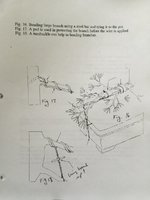Dav4 nailed it. The wire is too large, which makes it hard to wrap around so that it supports the branch. Instead it is leveraging the branch down and away from the trunk.You always want the wire to be on the outside of a bend. Looking at the picture with the wire and zip ties, you can see how the wire in it's current placement would actually help tear the branch away from the trunk if you tried to bend the branch downward right where it attaches to the trunk. A better way would have been to have the wire come from below and wrap directly over the top of the branch, esentially the opposite of what we've got here. Fwiw, it took me years to figure this out on my own... welcome to the club. Another possible contributor to your issue is that the chosen wire might be a bit heavy for the job, and a slightly smaller gauge would probably have been better.
All that aside, as long as there’s sufficient wood to support the broken branch, leaving the wire on and letting it callous over will allow the branch to come off at a sharper downward angle.
In fact, it is a valid technique to purposefully cut into the trunk at an angle above the branch! Then wire the branch down. Often you could insert a small pebble into the open slot to help the wire hold it down, then fill with cut paste.
Little known fact: John Naka’s “Goshin” was styled using exactly that technique! He “broke” (using the cutting technique above) the branches to get the branches into position, then wired them. The larger ones had a pebble inserted for support.


